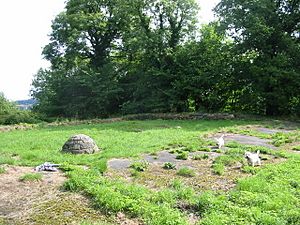Duffield Castle, Derbyshire facts for kids
Duffield Castle was a Norman castle located in Duffield, Derbyshire. Today, the site is a protected historical monument.
The castle stood on a rocky hill that was easy to defend. Rivers surrounded it on three sides, making it hard for enemies to climb. It's not clear if people lived here before the castle was built. However, Roman soldiers might have used the spot. They could have protected a nearby shallow river crossing. This crossing was important for people traveling from Wirksworth to join a main Roman road near Derby.
Archaeologists have found old items from the Anglo-Saxons at the site. These suggest that a Saxon lord named Siward, or his family, might have lived there. Many pieces of Roman pottery and roof tiles have also been found. Some of these items are now kept in the Derby Museum.
The Norman Castle's Story
Henry de Ferrers was a loyal helper to King William the Conqueror. Because of his service, he received a lot of land in Derbyshire. This area became known as Duffield Frith. Henry built Tutbury Castle as his main home. He also built a castle at Duffield. This second castle helped protect the northern part of his lands. The first Duffield Castle was likely made of wood.
The Earls of Derby
Henry's grandson, Robert, fought in a big battle against the Scots in 1138. After this, he became the first Earl of Derby.
His great-grandson, William, became Earl in 1162. William supported the King's sons when they rebelled against King Henry II. Because of this, both Tutbury and Duffield castles were destroyed in 1173.
Later, William II was a favorite of King John. He got back lands like Wirksworth and Ashbourne. The castles at Tutbury and Duffield were then rebuilt, this time with strong stone. William III was also well-liked by the King.
The next Earl, Robert (the seventh in his family), fought against King Henry III. Tutbury Castle was destroyed again. The King forgave Robert once, but Robert rebelled again. He was defeated in a battle at Chesterfield. In 1269, Robert lost all his lands. Duffield Castle was completely destroyed. Most of its stones were taken away to build other structures. Over time, the castle site returned to nature.
Discovering the Past
When the Duffield Castle site was first explored, people found the base of a traditional Norman castle. This type of castle is called a motte and bailey. It has a large mound (motte) and a courtyard (bailey). The main part of the castle, called the keep, was built on a huge rock. This rock was about 98 feet long and 95 feet wide. It was only a little smaller than the famous White Tower in London.
The castle grounds, with their clear foundation shapes, were given to the National Trust in 1899. The National Trust is an organization that protects historic places. For many years, the local Parish Council looked after the site. Recently, the National Trust took over this role again.
More surveys in the 1930s and 1957 confirmed that people lived on the site before the Normans arrived. Many Roman and Romano-British items were found.
In 2001, the University of Bradford did a special scientific survey called a geophysical investigation. This survey uses equipment to look underground without digging. They found traces of other buildings to the south and southeast of the castle. These buildings seemed to be from the same time period. The National Trust is now trying to raise money to do more investigations.
Images for kids
-
Norman bucket from Duffield Castle well – now in Derby Museum




